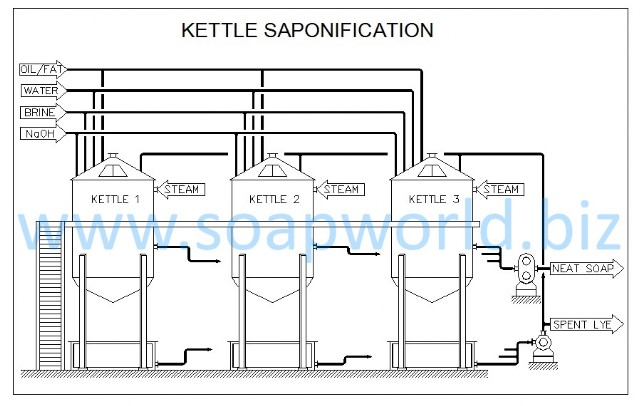6a. Kettles Saponification Plant for Full-Boiled Soap
Soap Manufacturing > 6. Industrial Soap Manufacturing
There are different types of Saponification Plants used in soap industry to produce soap; the mainly divided by the following criteria:
- Continuous or Batch saponification plants: division carried out according to the process
- Semi Boiled or Full Boiled saponification plants: division carried out according to the final soap
KETTLE SAPONIFICATION PLANT for FULL BOILED SOAP
This is the oldest system able to produce soap and glycerin starting from vegetable oils and animal fats. During the last decades this type of saponification plant was improved (by mean of Jet saponification device) or was replaced by continuous saponification plant in reactor due to the following reasons:
- Very high steam consumption
- Very long time saponification process
- Low flexibility when the formulas changing is required
- Big installation space required
- management difficulties and the need of highly experienced soap makers
In a traditional kettle saponification plant three or more saponification kettles are installed with a dimensions variable from 10 to 100 cubic meters. On the bottom part of each kettle a round spiral coil is assembled for the steam flow that is the only thing that is necessary for heating. Steam is also the only way to mix the reagents.
The steam flow direction is very important for a homogeneous saponification reaction: it must create two vortexes to the center to the external part of the kettle, one in rotary direction and the other one in anti-rotatory sense. If the steam flow directions are not correct, some parts of the raw materials are stopped and not well amalgamate; this compromise the homogenization of the saponification. The steam flow direction is comparable to a mechanical mixing action. In the kettle saponification an additional kettle is required; it is used in the case of errors in the process, to recover the mixture of reagents; example: if all the saponification kettles are full but the process has been wrong (too much soda or too much oil), it is necessary to use the additional kettle where discharge the mixture to make the corrections.
The raw materials are feed in the saponification kettle that must already contains a portion of lies to help the starting of the saponification reaction. When the saponification is completed, the second step is the soap graining: a brine solution (NaCl in H2O) is added in the kettle and mixed with the soap. This procedure generates a separation of the mixture. The soap goes up on the upper part of the kettle, while the lye (glycerin, water and NaOH in excess) goes down on the bottom part of the kettle.
The next step is the settle and the lye removal. When the mixture is well separated in two layers, the lye are removed from the bottom part of the kettle and are loaded in previous kettle. After the washing of this kettle the lye are loaded in the previous kettle and so on. This process is called counter current washing process, and it is used to wash the soap using the same lye with the scope to recovery more glycerin during each washing. The process is repeated to increase the number of the washings until the soap is ready. At this point the spent lye are reach of glycerin and can be pumped to the glycerin recovery plant.
The last step is the fitting, necessary to remove the lye in excess, to adjust the free alkalinity and the NaCl in the soap.
The soap produced by means of kettle saponification plant is called Full Boiled Soap and usually has a TFM of about 60%. When the soap is ready, it is pumped to the vacuum drying plant.

